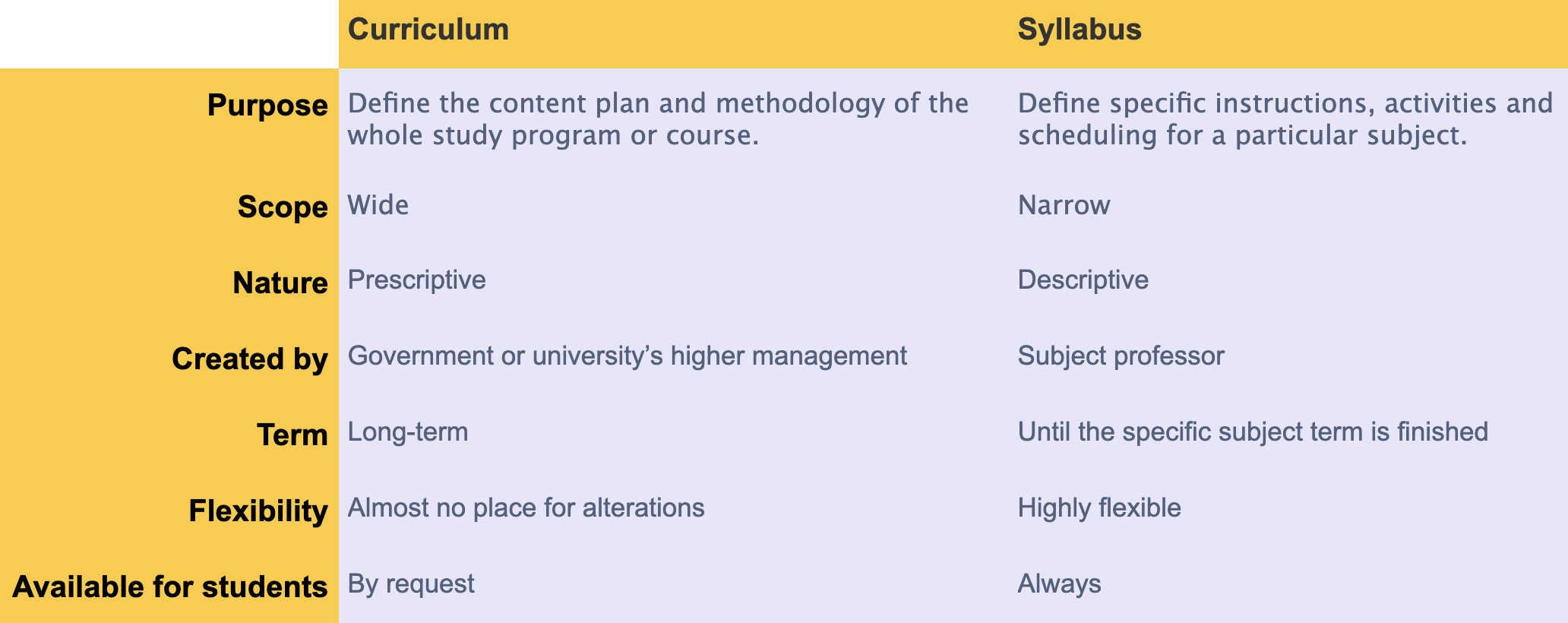Curriculum and Syllabus are two main documents widely used in the education process. The general purpose of both is to organize the proper relationship between professors and students and define both sides' responsibilities and requirements.
In a simple explanation, the two documents are formal written descriptions of the studying units: a curriculum for the global studying program or course and a Syllabus for smaller scales like a specific subject.
If you plan to be involved in the education process, either as a professor or a student, understanding the Curriculum and Syllabus structure is essential. These two terms are usually referred to as very similar or sometimes the same at the amateur level. However, in practice, there are core differences, which are described further in this article.
But first, let's discuss each separately.
Curriculum
The curriculum is the guideline of the whole academic content covered during a specific course or program. It's the list of exact instructions on what professors should teach, how, and why.
The curriculum is the predefined combination of the rules and techniques through which the academic course's purpose should be realized. It's written and approved, having the student's mental and physical development as the main goal.
As a list of instructions, the curriculum is formed by the university or government authorities. In private universities, it is usually written and approved by the higher administration, whereas this role is for government officials in governmental institutions.
The curriculum usually consists of the following parts:
instructional content
materials and resources
physical and mental activities for the students
assignments, tests, exams
student success evaluation methods.
For a better picture, check the curriculum sample for an Integrated course of Medical Education at Yale.
Syllabus
As a logical continuation of the curriculum, Syllabus describes the whole academic content covered in a particular subject. It might be explained as a curriculum's practical implementation plan, designed by the subject professor.
A syllabus is provided to students at the beginning of the study process as a detailed outline of everything they will learn and submit within the subject. That's a convenient way to introduce the load and schedule of activities to students.
The Syllabus usually contains the following sections:
Instructor and subject information
Objectives and policies
Grading and Evaluation system
Learning resources
Assignment descriptions and deadlines.
The following syllabus sample of Integrated Product Conceptualization will help to understand the above-described explanation better.
Comparison chart

Key differences between curriculum and syllabus
The above-given comparison chart showed that curriculum and Syllabus have several differences despite the same general idea behind them. This section will sum up those differences in more detail.
1. The curriculum is a general, standardized description for the main study units of the educational institution. Beyond the study program or course, It may even relate to the whole university. On the contrary, Syllabus is a detailed content plan for a particular subject.
2. The curriculum is mandatory. It's more like a global strategy, with almost no space for alterations in implementation. The Syllabus is highly flexible and may even change during the study process based on professor-student verbal agreements.
3. The university authorities created the curriculum as a result of deeper analysis and discussions compared to Syllabus. The latter is designed based on the professor's creativity, preferences, and approaches.
4. The curriculum mostly focuses on the result of the study program as a product. It plans the major set of activities such as the course's outcome, the quantity, and forms of academic works necessary to complete within the course. The Syllabus focused on day-to-day operations in class.
5. The curriculum doesn't follow the personalized approach. It's the same for all the teachers and students. The curriculum may be changed to adopt a more personalized approach if there is an urgent need to refresh the old policy due to technology changes, the employment market, and generation mentality. The Syllabus reflects the personal approach of the professor. Also, year-to-year student review evaluations have an impact on students' individual preferences on Syllabus.
6. The level of seriousness of the curriculum assumes that it's created once for a significantly long-term period. The Syllabus is designed for a certain period of a class studying a subject.
7. The curriculum is mainly designed for teachers to plan their work, and there is usually no point in sharing it with students. On the opposite, Syllabus is given to students from the very beginning of their studies. It is mainly purposed to understand their benefits and responsibilities for the subject.
Common for both
Both documents are designed to make the studying process more organized and smoother.
Both should be strictly followed during the study program.
University administration determines and monitors both curriculum and Syllabus.
Both documents are a form of agreement between professors and students.
Conclusion
Curriculum and Syllabus are effective tools for planning the comprehensive teaching process in detail.
Having those documents in hand, professors distribute their time and teaching purpose more effectively. Careful planning decreases the probability of incorrect time management and the risks of leaving important information out of the course time.
For students, syllabuses of different subjects help to schedule their time in advance to have enough time to submit all assignments and grasp the new information successfully.
Both professors and students combine many study programs simultaneously, and it's easy to lose the clue if one detail goes wrong. Here, an organized timeline of activities comes in very handy.
Besides, both curriculum and Syllabus are a part of communication ethics, an educated way of mutual agreement between professors and students, improving the overall atmosphere.
They say: Failed to plan, plan to fail! So, make sure you make the most out of the planning tools offered to you.
Published on Dec 23, 2020




